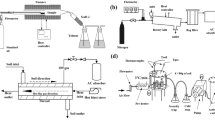Abstract
To evaluate the effectiveness of the thermal remediation of soil decontamination, samples containing organochlorine insecticide hexachlorocyclohexane (HCH) were subjected to different temperatures depending on the exposure time. For this study, reference material and technical grade HCH were heated separately at β = 1 and 10 °C min−1 in a thermogravimetric analyzer and contaminated soil samples were heated in an oven at different temperatures and heating time. To determine gaseous emissions generated during the heating of HCH isomers, HCH technical grade samples were heated in a closed system (reactor) and sample gases/vapors were collected for qualitative analysis. The results indicate that the contaminants are removed from soil to temperatures considerably lower than the respective boiling point. The thermogravimetric curves have shown that heating to 400 °C HCH results in fusion processes followed by evaporation, and investigating in the oven, the reduction in HCH concentration present in the contaminated soil depends on the temperature and length of heating. Gaseous emissions detected were from isomers of HCH, chlorine derivatives and benzene compounds. The laboratory tests show that parameters such as temperature, heating time and air flow can influence the thermal decontamination process of the subsoil.








Similar content being viewed by others
References
Kingston JT, Dahlen PR, Johnson PC, Foote E, Williams S. Critical evaluation of state-of-the-art in situ thermal treatment technologies for DNAPL source zone treatment. 2010. http://www.clu-in.org/download/techfocus/thermal/Thermal-ER-0314-FR.pdf. Accessed 4 Jan 2010.
United States Environmental Protection Agency. How to evaluate alternative cleanup technologies for underground storage tank sites: a guide for corrective action plan reviewers. Washington. DC: Usepa; 1995.
Qi Z, Chen T, Bai S, Yan M, Lu S, Buekens A, Yan J, Bilmãu C, Li X. Effect of temperature and particle size on the thermal desorption of PCBs from contaminated soil. Environ Sci Pollut Res. 2014. doi:10.1007/s1135601323924.
Stegemeier GL, Vinegar HJ. Thermal conduction heating for in situ thermal desorption of soils. In: Oh CH, editor. Hazardous and radioactive waste treatment technologies handbook. Boca Raton: CRC Press; 2001.
Risoul V, Renauld V, Trouvé G, Gilot P. A laboratory pilot study of thermal decontamination of soils polluted by PCBs. Comparison with thermogravimetric analysis. Waste Manag. 2002;22:61–72.
Risoul V, Pichon C, Trouvé G, Peters WA, Gilot P, Prado G. Thermogravimetric study of thermal decontamination of soils polluted by hexachlorobenzene, 4-chorobiphenyl, naphthalene, or n-decane. J Hazard Mater. 1999;64:295–311.
Kucerík J, Siewert C. Practical application of thermogravimetric in soil science. Part 2. Modeling and prediction of soil respiration using thermal mass losses. J Therm Anal Calorim. 2014;116:563–70.
Agency for Toxic Substances and Disease Registry. Toxicological profile for alpha, beta-, gamma-, and delta-hexachlorocyclohexane. Atlanta: ATSDR; 2005.
Environmental Agency of the São Paulo State–Brazil. Toxicological Information Sheet: hexachlorocyclohexane. CETESB:2014. http://www.cetesb.sp.gov.br/userfiles/file/laboratorios/fit/Hexaclorociclohexanos.pdf. Accessed 01 Mar 2014.
Brazilian Association of Technical Standards. NBR 7181: particle size analysis of soils. Rio de Janeiro: ABNT; 1984.
Environmental Agency of the São Paulo State–Brazil. Decision of directors No. 045/2014/E/C/I, of 20 February: 2014. http://www.cetesb.sp.gov.br/userfiles/file/solo/valores-orientadores-2014.pdf. Accessed 28 Feb 2014.
Rodant F, Vechio S, Catalani G, Guidotti M. Thermal analysis and non-isothermal kinetics study of some pesticides: part II—chlorinate derivatives. J Therm Anal Calorim. 2000;60:606–22.
Huang YT, Hseu ZY, Hsi HC. Influences of thermal decontamination on Mercury removal, soil properties and repartitioning of coexisting heavy metals. Chemosphere. 2011;84:1244–9.
Gilot P, Howard JB, Peters W. Evaporation phenomena during thermal decontamination of soils. Environ Sci Technol. 2007;37:461–6.
Ukisu Y, Miyadera T. Dechlorination of hexachlorocyclohexanes with alkaline 2-propanol and palladium catalyst. J Hazard Mater. 2005;122:1–6.
Author information
Authors and Affiliations
Corresponding author
Rights and permissions
About this article
Cite this article
Araújo, M.M., Ignatius, S.G., Oliveira, A.O. et al. Thermal desorption of HCH. J Therm Anal Calorim 123, 1019–1029 (2016). https://doi.org/10.1007/s10973-015-4810-y
Received:
Accepted:
Published:
Issue Date:
DOI: https://doi.org/10.1007/s10973-015-4810-y




